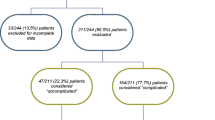Abstract
Introduction and hypothesis
Multichannel urodynamic testing is commonly used to diagnose urodynamic stress incontinence (USI). It has been claimed that USI may be diagnosed by imaging. In this study we determined the predictive value of ultrasound findings for USI.
Methods
This is an observational study utilising data obtained during urodynamic testing. Data sets were analysed in 209 patients in order to determine the predictive value of sonographic findings for the diagnosis of USI.
Results
Bladder neck descent and maximal urethral pressure were the only independent predictors of USI identified by multivariate logistic regression. The finding of a cystourethrocele with funnelling increased the odds of a diagnosis of USI by 2.5 (95 % confidence interval 1.17–5.4, p = 0.018).
Conclusions
Translabial ultrasound can identify an anatomical configuration that is associated with USI. However, sonographic findings are insufficient to predict USI and can not replace urodynamic testing.


Similar content being viewed by others
References
Lemack GE (2004) Urodynamic assessment of patients with stress incontinence: how effective are urethral pressure profilometry and abdominal leak point pressures at case selection and predicting outcome? Curr Opin Urol 14(6):307–311
Huang Y, Chen H (2007) Computer-aided diagnosis of urodynamic stress incontinence with vector-based perineal ultrasound using neural networks. Ultrasound Obstet Gynecol 30(7):1002–1006
Lewicky-Gaupp C, Blaivas JG, Clark A, McGuire EJ, Schaer G, Tumbarello J, Tunn R, DeLancey J (2009) “The cough game”: are there characteristic urethrovesical movement patterns associated with stress incontinence? Int Urogynecol J Pelvic Floor Dysfunct 20(2):171–175
Dietz HP (2011) Pelvic floor ultrasound in incontinence: what’s in it for the surgeon? Int Urogynecol J 22(9):1085–1097
Dietz HP (2011) Pelvic floor ultrasound in prolapse: what’s in it for the surgeon? Int Urogynecol J 22:1221–1232
Shek KL, Dietz HP (2008) The urethral motion profile: a novel method to evaluate urethral support and mobility. Aust N Z J Obstet Gynaecol 48:337–342
Green TH (1975) Urinary stress incontinence: differential diagnosis, pathophysiology, and management. Am J Obstet Gynecol 122(3):368–400
Hall AF, Theofrastous JP, Cundiff GW, Harris RL, Hamilton LF, Swift SE, Bump RC (1996) Interobserver and intraobserver reliability of the proposed International Continence Society, Society of Gynecologic Surgeons, and American Urogynecologic Society pelvic organ prolapse classification system. Am J Obstet Gynecol 175 (6):1467–1470; discussion 1470–1471; comment in Am J Obstet Gynecol, 1997, 177:248
Dietz HP, Shek KL (2008) Validity and reproducibility of the digital detection of levator trauma. Int Urogynecol J Pelvic Floor Dysfunct 19:1097–1101
Eisenberg V, Chantarasorn V, Shek K, Dietz H (2010) Does levator ani injury affect cystocele type? Ultrasound Obstet Gynecol 36:618–623
Chantarasorn V, Dietz H (2012) Diagnosis of cystocele type by clinical examination and pelvic floor ultrasound. Ultrasound Obstet Gynecol 39(6):710–714
Abrams P, Cardozo L, Fall M, Griffiths D, Rosier P, Ulmsten U, van Kerrebroeck P, Victor A, Wein A, Standardisation Sub-committee of the International Continence Society (2002) The standardisation of terminology of lower urinary tract function: report from the Standardisation Sub-committee of the International Continence Society. Neurourol Urodyn 21(2):167–178
Holtedahl K, Verelst M, Schiefloe A, Hunskaar S (2000) Usefulness of urodynamic examination in female urinary incontinence—lessons from a population-based, randomized, controlled study of conservative treatment. Scand J Urol Nephrol 34:169–174
Lose G, Thyssen H (1996) Reproducibility of cystometry and pressure-flow parameters in female patients. Neurourol Urodyn 15:302–303
Weidner A, Myers ER, Evan R, Visco A, Cundiff G, Bump R (2001) Which women with stress incontinence require urodynamic evaluation? Am J Obstet Gynecol 184:20–27
Hodgkinson CP (1953) Relationships of the female urethra and bladder in urinary incontinence. Am J Obstet Gynecol 65:560–573
Green TH Jr (1978) Static cystourethrograms in stress urinary incontinence. Am J Obstet Gynecol 132(2):228–232
Drutz HP, Shapiro BJ, Mandel F (1978) Do static cystourethrograms have a role in the investigation of female incontinence? Am J Obstet Gynecol 130(5):516–520
Dietz H, Wilson P (2004) The ‘iris effect’: how two-dimensional and three-dimensional ultrasound can help us understand anti-incontinence procedures. Ultrasound Obstet Gynecol 23:267–271
Dietz HP, Beer-Gabel M (2012) Ultrasound in the investigation of posterior compartment vaginal prolapse and obstructed defecation. Ultrasound Obstet Gynecol 40:14–27
Lose G (1997) Urethral pressure measurement. Acta Obstet Gynecol Scand Suppl 166:39–42
Dietz HP, Clarke B (2001) The urethral pressure profile and ultrasound imaging of the lower urinary tract. Int Urogynecol J Pelvic Floor Dysfunct 12(1):38–41
Pirpiris A, Shek K, Dietz H (2010) Urethral mobility and urinary incontinence. Ultrasound Obstet Gynecol 36:507–511
Dietz H, Bond V, Shek K (2011) Does childbirth alter the reflex pelvic floor response to sudden increases in intra-abdominal pressure? Ultrasound Obstet Gynecol. doi:10.1002/uog.10083
Dietz HP, Wilson PD (1999) The influence of bladder volume on the position and mobility of the urethrovesical junction. Int Urogynecol J Pelvic Floor Dysfunct 10(1):3–6
Conflicts of interest
Prof. H.P. Dietz has received honoraria as a speaker from GE, Astellas and AMS and has in the past acted as consultant for CCS, AMS and Materna. He has also received equipment loans from GE, Toshiba and Bruel and Kjaer. The other authors have no potential conflicts of interest to declare.
Author information
Authors and Affiliations
Corresponding author
Rights and permissions
About this article
Cite this article
Dietz, H.P., Nazemian, K., Shek, K.L. et al. Can urodynamic stress incontinence be diagnosed by ultrasound?. Int Urogynecol J 24, 1399–1403 (2013). https://doi.org/10.1007/s00192-012-2032-4
Received:
Accepted:
Published:
Issue Date:
DOI: https://doi.org/10.1007/s00192-012-2032-4




